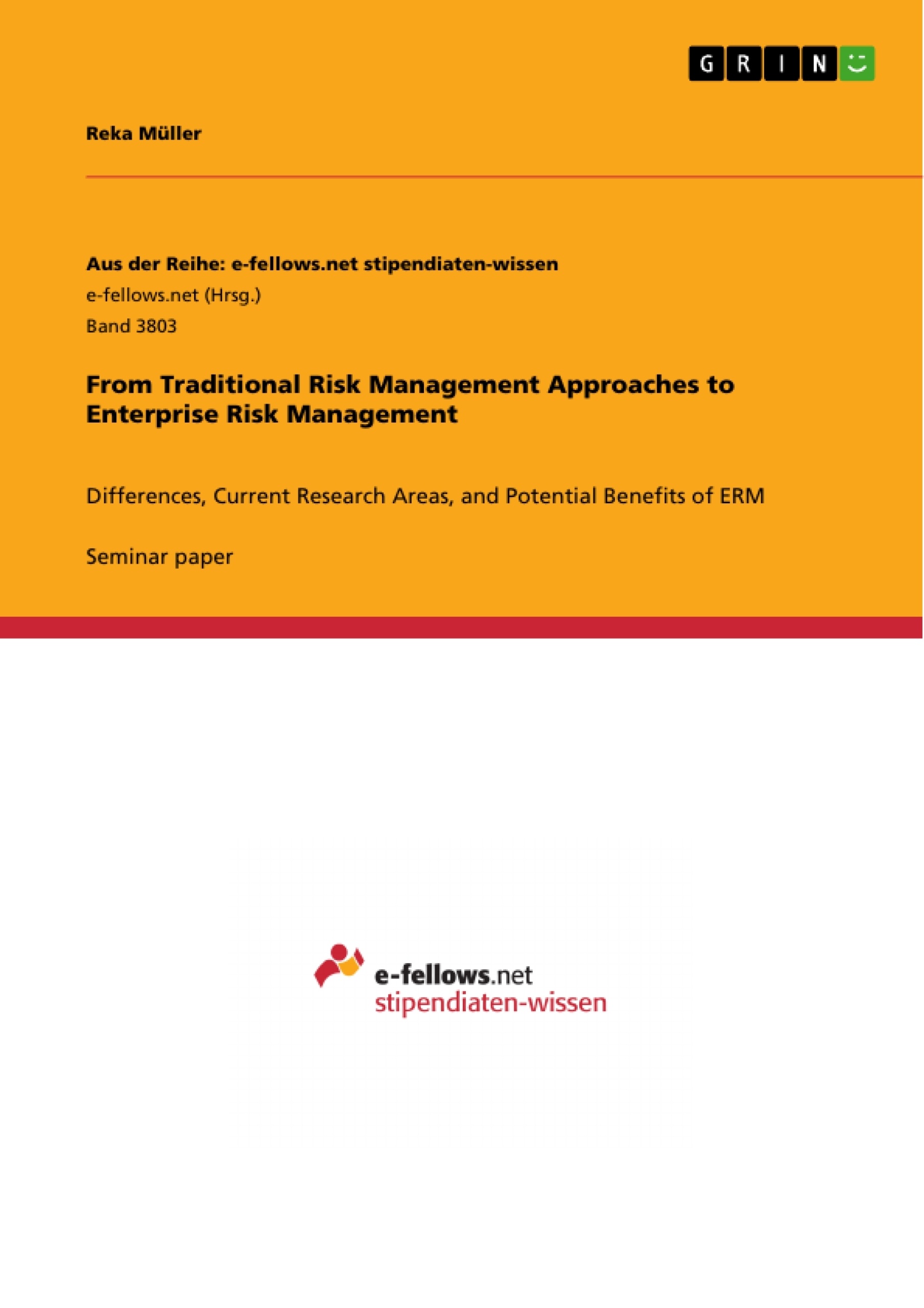Risk Management systems are used by nearly every company nowadays, also because of increasing regulatory requirements like the Sarbanes Oxley Act from 2002 or Solvency II from 2016. These frameworks call for an integrated perspective on firms' risk portfolios. Enterprise Risk Management (ERM) is a risk management system that considers risk on the entity level and is, therefore, an alternative to traditional, silo-based risk management approaches. This literature review compares the results of 25 empirical studies concerning the value-creating potential of ERM and whether companies might benefit from the implementation.
Table of Contents
- Introduction
- Methodology
- Literature Review
- Definition of ERM and differentiation from traditional risk management approaches
- Research streams
- Determinants of ERM implementation
- Enterprise Risk Management and value creation
- Comparison of the results with a prior literature review
- Conclusion
Objectives and Key Themes
This seminar paper investigates the value creation potential of Enterprise Risk Management (ERM) and the factors influencing its implementation. It aims to synthesize findings from empirical research to determine whether ERM consistently generates value for firms and to identify key characteristics that promote or hinder its adoption.
- The value creation potential of ERM.
- Comparison of ERM with traditional risk management approaches.
- Determinants of ERM implementation across different firms.
- Analysis of empirical research on ERM's impact on financial performance.
- Synthesis of existing literature to draw conclusions about ERM effectiveness.
Chapter Summaries
Introduction: This introductory chapter establishes the context for the study by highlighting the increased relevance of risk management, particularly in light of recent global economic events like the Coronavirus pandemic. It underscores the importance of ERM as a holistic approach, contrasting it with traditional, siloed methods. The chapter introduces the central research question: Does ERM create value for implementing firms? This is investigated by analyzing empirical studies on the relationship between ERM and value creation, acknowledging the mixed findings in prior research. The introduction also previews the examination of factors influencing ERM implementation.
Methodology: [Note: The provided text lacks detail on the methodology. A summary would need to be generated based on further information about the research methods used in the paper.]
Literature Review: This chapter provides a comprehensive overview of existing literature on ERM. It begins by defining ERM and distinguishing it from traditional risk management approaches, emphasizing ERM's holistic and integrated nature. The review delves into various research streams focusing on ERM's impact on value creation and the determinants of its implementation. It synthesizes findings from numerous empirical papers to assess the existing consensus (or lack thereof) surrounding the benefits and challenges associated with adopting an ERM system. The chapter's purpose is to lay the groundwork for the analysis presented in the main sections of the paper, providing a detailed background and context for the research questions posed.
Conclusion: [Note: As per instructions, the conclusion is excluded to avoid spoilers.]
Keywords
Enterprise Risk Management (ERM), Traditional Risk Management (TRM), Value Creation, Risk Management Implementation, Empirical Research, Financial Performance, Corporate Governance, Regulatory Requirements, Value Volatility, Capital Efficiency.
Frequently Asked Questions: A Comprehensive Language Preview
What is the purpose of this document?
This document provides a comprehensive preview of a research paper investigating the value creation potential of Enterprise Risk Management (ERM) and the factors influencing its implementation. It includes the table of contents, objectives and key themes, chapter summaries, and keywords.
What topics are covered in the paper?
The paper examines the value creation potential of ERM, comparing it to traditional risk management approaches. It explores the determinants of ERM implementation across different firms, analyzes empirical research on ERM's impact on financial performance, and synthesizes existing literature to draw conclusions about ERM effectiveness. The impact of recent global events, such as the Coronavirus pandemic, on the relevance of risk management is also discussed.
What is the methodology used in the research?
The provided text lacks specific details on the research methodology. This information would be included in a dedicated methodology chapter of the full paper.
What are the key themes explored in the paper?
Key themes include the value creation potential of ERM, the comparison of ERM with traditional risk management, determinants of ERM implementation, analysis of empirical research on ERM's impact on financial performance, and a synthesis of existing literature to assess ERM effectiveness.
What are the chapter summaries?
The Introduction sets the context, highlighting the increased relevance of risk management and introducing the central research question: Does ERM create value? The Methodology section (details missing in preview) would describe the research methods used. The Literature Review provides a comprehensive overview of existing literature on ERM, defining it, comparing it to traditional approaches, and synthesizing findings on its impact and implementation determinants. The Conclusion (excluded from this preview) would summarize the findings and draw conclusions.
What are the key words associated with this research?
Key words include Enterprise Risk Management (ERM), Traditional Risk Management (TRM), Value Creation, Risk Management Implementation, Empirical Research, Financial Performance, Corporate Governance, Regulatory Requirements, Value Volatility, and Capital Efficiency.
What is the difference between ERM and Traditional Risk Management (TRM)?
The paper distinguishes between ERM and TRM, highlighting ERM's holistic and integrated nature in contrast to the more siloed approaches of traditional risk management. Specifics of this comparison are detailed in the Literature Review chapter.
What is the overall conclusion of the research (as previewed)?
The conclusion is not included in this preview to avoid spoilers. The full paper would contain a detailed conclusion based on the analysis of the research findings.
- Quote paper
- Reka Müller (Author), 2021, From Traditional Risk Management Approaches to Enterprise Risk Management, Munich, GRIN Verlag, https://www.hausarbeiten.de/document/1007524


